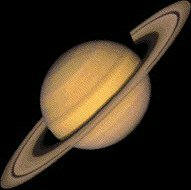
Saturn

Saturn is the sixth planet from the Sun. It is the second largest of the four gas giants in the solar system, but is also the lightest, having only one half the density of Jupiter. There are many moons orbiting the planet, only nine of which are particularly significant, Titan being the largest with a diameter of 5,150km and possessing an atmosphere of its own. Titan is the only planetary satellite known to have an atmosphere, the largest component of which is nitrogen. Other moons are Rhea (1,530km), Iapetus (1,460km), Dione (1,120km), Tethys (1,000km), Enceladus (500km), Mimas (392km), Phoebe (220km) and Hyperion, which is elongated, and measures 205km by 110km.
Rings The planet has an extensive system of rings which are composed of icy particles ranging in size from pebbles to beach balls. These rings appear from Earth as distinct bands with divisions between them, the main rings being designated a letter to identify them, while the gaps are named after the astronomers who first discovered them. Spacecraft data taken close to the rings reveals many more such bands with finer detail. This data also indicated that the ring thickness was no more than 150m, with their temperature in sunlight at around -180 degC and as low as -200 degC in shadow.. A few of the smaller moons lie within the ring system and are seen to influence their surroundings. For example, two moons, Prometheus and Pandora, are seen to 'shepherd' the particles of a ring held between them.
Composition The composition of the planet is very similar to that of Jupiter, with a silicate core surrounded by liquid hydrogen, and a deep gaseous hydrogen atmosphere. This atmosphere is cooler than Jupiter's, and, while displaying similar banding, the colouring is less vivid, due to a haze of ammonia crystals at its outer reaches. Wind speeds of up to 1,400km/h have been detected, and give an indication of extreme meteorological activity.
Probes to Saturn After a brief fly-pass by Pioneer 11 in 1979, Voyagers 1 and 2 sent back much important information about the planet, its satellites and rings during their encounters in 1980 and 1981.

The Cassini probe, launched in October 1997, will rendez-vous with Saturn in 2003, entering a permanent orbit. It is named after the Italian-born French Astronomer Giovanni Cassini (1625-1712), who discovered the major gap (see photo above) in Saturn's rings; the Cassini Division. Cassini's 12 instruments will measure magnetic fields, plasmas, dust particle densities, Saturn&rsquos weather and the geology of several of Saturn's moons.
A Titanic Visit The ESA-built Huygens probe, on board Cassini, will detach and parachute to the surface of Titan in 2004. The tour selected also allows superior, long-term studies of Saturn's rings, detailed mapping of Saturn, and measurements of Saturn's magnetic field. In addition, the tour includes three specially targeted close flybys of the moon Enceladus, and one each of Dione, Rhea, Hyperion and Iapetus.